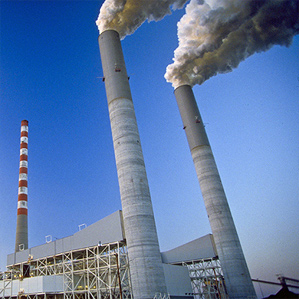Will Obama’s Climate Policy Spur New Energy Technologies?
This week, when President Obama announced his new plan to address climate change largely through new regulations on carbon dioxide emissions from power plants, he sang the praises of technological progress, arguing that in the past, regulations spurred innovation that in turn helped the economy (see “Obama Orders EPA to Regulate Power Plants in Wide-Ranging Climate Plan”).

But it’s not clear that regulations alone will prompt enough innovation to solve climate change. “If you’re going to do this regulatory effort, there has to be a parallel effort in the technology innovation process if you’re really going to maximize your ability to reach these goals,” says Henry Lee, director of the Environmental and Natural Resources Program at Harvard’s Kennedy School of Government.
In any case, it is clear that the new plan represents a major scaling back in ambition since the beginning of the president’s first term—a change prompted by a struggling economy and a divided Congress. In the 2009 stimulus bill, the administration called for and got tens of billions of dollars to research and demonstrate new energy technology. But Obama’s 2014 budget asks for only a modest increase in R&D spending—and even that will have a difficult time making it through Congress. Further, the regulatory scheme he’s proposed for limiting carbon dioxide emissions from power plants is far smaller in scope than the economy-wide cap-and-trade legislation he once pursued.
Regulations, along with international treaties, have certainly had a powerful impact in the past, prompting a rapid phaseout of ozone-destroying CFCs, for example (see “Remembering the Montreal Protocol”). But addressing carbon dioxide emissions is a far larger, more difficult problem. And several factors will limit the scope of the carbon-emissions regulations Obama is pushing forward under the Clean Air Act. That in turn will limit how much innovation they prompt.
The process for developing regulations under the Clean Air Act could make it difficult to achieve large reductions in carbon dioxide levels. The specifics of the proposed regulations—including how much carbon emissions are to be reduced, by what means, and at what rate—will be determined through a series of proposals, comment periods, meetings with utilities and other stakeholders, and, no doubt, legal challenges. Altogether this process could weaken the regulations or even block them, and it will almost certainly delay their implementation until well after President Obama has left office, perhaps to be replaced by someone who doesn’t favor them.
“If I know that there is a market that the government is going to create for low-carbon options, and that that market is going to be sustainable, there’s thousands of different entrepreneurs who will find thousands of different options. But if I don’t think that demand is going to be there, if I think that demand is fairly fickle, that it depends on which party wins the 2016 election, I’m not going to put my money into this,” Lee says.
Lee thinks at least some utilities and suppliers will assume that some level of carbon-emissions regulation will be implemented. Yet even so, the tendency of the industry is to make modest changes, such as improving efficiency or switching from coal to natural gas, rather than to take a risk on new technologies. “One would have to expect very stringent emissions limits for there to be strong incentives to develop radical alternatives,” says Gregory Nemet, professor of public affairs and environmental studies at the University of Wisconsin at Madison.
Incremental changes could be fine for meeting near-term emissions goals in the United States, but they may not be enough to reduce emissions by 80 percent worldwide, as some scientists say we must do to avoid dangerous global warming. It may be necessary to develop new kinds of nuclear power plants, for example. Or to capture carbon dioxide from power plants and bury vast volumes of it underground (see “What Carbon Capture Can’t Do”).
Ultimately, it’s uncertain how the regulations will affect technology development. “I can’t guarantee that if you put the carbon-emissions regulations in place that this will have a huge effect of inducing or stimulating new power technologies,” Lee says. “It might. It will certainly have some effect. But how much? I don’t know.”
Keep Reading
Most Popular
Large language models can do jaw-dropping things. But nobody knows exactly why.
And that's a problem. Figuring it out is one of the biggest scientific puzzles of our time and a crucial step towards controlling more powerful future models.
The problem with plug-in hybrids? Their drivers.
Plug-in hybrids are often sold as a transition to EVs, but new data from Europe shows we’re still underestimating the emissions they produce.
How scientists traced a mysterious covid case back to six toilets
When wastewater surveillance turns into a hunt for a single infected individual, the ethics get tricky.
Google DeepMind’s new generative model makes Super Mario–like games from scratch
Genie learns how to control games by watching hours and hours of video. It could help train next-gen robots too.
Stay connected
Get the latest updates from
MIT Technology Review
Discover special offers, top stories, upcoming events, and more.